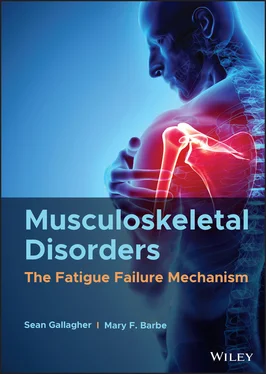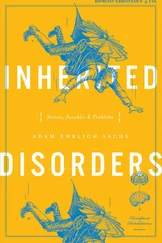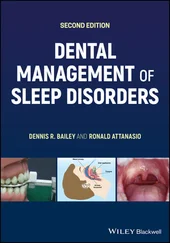Sean Gallagher - Musculoskeletal Disorders
Здесь есть возможность читать онлайн «Sean Gallagher - Musculoskeletal Disorders» — ознакомительный отрывок электронной книги совершенно бесплатно, а после прочтения отрывка купить полную версию. В некоторых случаях можно слушать аудио, скачать через торрент в формате fb2 и присутствует краткое содержание. Жанр: unrecognised, на английском языке. Описание произведения, (предисловие) а так же отзывы посетителей доступны на портале библиотеки ЛибКат.
- Название:Musculoskeletal Disorders
- Автор:
- Жанр:
- Год:неизвестен
- ISBN:нет данных
- Рейтинг книги:5 / 5. Голосов: 1
-
Избранное:Добавить в избранное
- Отзывы:
-
Ваша оценка:
- 100
- 1
- 2
- 3
- 4
- 5
Musculoskeletal Disorders: краткое содержание, описание и аннотация
Предлагаем к чтению аннотацию, описание, краткое содержание или предисловие (зависит от того, что написал сам автор книги «Musculoskeletal Disorders»). Если вы не нашли необходимую информацию о книге — напишите в комментариях, мы постараемся отыскать её.
Hands-on guidance and tools for the prevention of musculoskeletal injuries in the workplace Musculoskeletal Disorders: The Fatigue Failure Mechanism,
Musculoskeletal Disorders: The Fatigue Failure Mechanism
Musculoskeletal Disorders — читать онлайн ознакомительный отрывок
Ниже представлен текст книги, разбитый по страницам. Система сохранения места последней прочитанной страницы, позволяет с удобством читать онлайн бесплатно книгу «Musculoskeletal Disorders», без необходимости каждый раз заново искать на чём Вы остановились. Поставьте закладку, и сможете в любой момент перейти на страницу, на которой закончили чтение.
Интервал:
Закладка:
17 McEwan, B. (1998). Stress, adaptation, and disease: Allostasis and allostatic load. Annals of the New York Academy of Sciences, 840, 33–44.
18 Mehdizadeh, A., Vinel, A., Hu, Q., Schall, M., Jr., Gallagher, S., & Sesek, R. (2020). Job rotation and work‐related musculoskeletal disorders: A fatigue‐failure perspective. Ergonomics, 63, 461–476.
19 Miner, M. A. (1945). Cumulative damage in fatigue. Journal of Applied Mechanics, 16, A159–A164.
20 Moore, J., & Garg, A. (1995). The strain index: A proposed method to analyze jobs for risk of distal upper extremity disorders. American Industrial Hygiene Association Journal, 56, 443–458.
21 Nash, J. C. (1966). Fatigue of self‐healing structure: A generalized theory of fatigue failure. New York: American Society of Mechanical Engineers.
22 Palmgren, A. (1924). Die Lebebsdaue rvon Kugellagern. Zeitschrift des Vereines Deutscher Ingenieure, 68, 339–341.
23 Potvin, J., Ciriello, V., Snook, S., Maynard, W., & Brogmus, G. (2021). The Liberty Mutual manual materials handling (LM‐MMH) equations. Ergonomics. https://doi.org/10.1080/00140139.2021.1891297
24 Radwin, R. G. (2011, September). Automated video exposure assessment of repetitive motion. In Proceedings of the human factors and ergonomics society annual meeting (Vol. 55, No. 1, pp. 995–996). Sage CA: Los Angeles, CA: SAGE Publications.
25 Rankine, W. (1843). On the causes of the unexpected breakage of the journals of railway axles, and on the means of preventing such accidents by observing the law of continuity in their construction. Minutes of the Proceedings of the Institution of the Institution of Civil Engineers (pp. 105–107). London: Institution of Civil Engineers.
26 Rempel, D. (2018). 1631c Recent changes to the ACGIH hand activity level TLV. Occupational and Environmental Medicine, 75(Suppl 2), A258–A258.
27 Schechtman, H., & Bader, D. (1997). In vitro fatigue of human tendons. Journal of Biomechanics, 829–835.
28 Snook, S. (1978). The design of manual handling tasks. Ergonomics, 21, 963–985.
29 Snook, S., & Ciriello, V. (1991). The design of manual handling tasks: Revised tables of maximum acceptable weights and forces. Ergonomics, 34, 1197–1213.
30 Stephens, R., Fatemi, A., Stephens, R., & Fuchs, H. (2001). Metal fatigue in engineering (2nd ed.). New York: John Wiley & Sons.
31 Sun, H., Andarawis‐Puri, N., Li, Y., Fung, D., Lee, J., Wang, V., … Flatow, E. L. (2010). Cycle‐dependent matric remodeling gene expression response in fatigue‐loaded rat patellar tendons. Journal of Orthopaedic Research, 28, 1380–1386.
32 Thornton, G., Schwab, T., & Oxland, T. R. (2007). Cyclic loading causes faster rupture and strain rate than static loading in medial collateral ligament at high stress. Clinical Biomechanics, 22, 932–940.
33 United States Bone and Joint Initiative. (2021, January). The burden of musculoskeletal diseases in the United States (BMUS), (3rd ed.), 2014. Rosemont, IL. Retrieved from http://www.boneandjointburden.org.
34 Waters, T., Putz‐Anderson, V., Garg, A., & Fine, L. (1993). Revised NIOSH equation for the design and evaluation of manual lifting tasks. Ergonomics, 36, 749–776.
35 Weightman, B., Chappell, D., & Jenkins, E. (1978). A second study of tensile fatigue properties of human articular cartilage. Annals of the Rheumatic Diseases, 37, 58–63.
36 Wright, J., Carroll, L., Sham, T.‐L., Lybeck, N., & Wright, R. (2016). Determination of the creep–fatigue interaction diagram for alloy 617. Proceedings of the ASME 2016 Pressure Vessels and Piping Conference (PVP2016) (p. 10). Vancouver, British Columbia, Canada: EPRI 2016 Creep Fatigue Workshop In Collaboration with ASME PVP.
2 Common Musculoskeletal Disorders
Overview
For the purpose of this book, the term “musculoskeletal disorders” (MSDs) refers to “conditions involving the experience of pain, discomfort, and/or disability in the human musculoskeletal system, usually as the result of cumulative damage to one or more of the components of this system, including muscles, tendons, ligaments, nerves, cartilage, ligaments, bone, and/or fascia.” Note that this definition excludes musculoskeletal injuries that might occur due to slips, trips, or falls (acute injuries). Instead, MSDs are viewed to be the consequence of exposure to repetitive stress resulting from occupational tasks, athletic pursuits, and other physical activities.
Terms used to describe MSDs over the past several decades include “repetitive stress injuries,” “repetitive strain injuries,” “cumulative trauma disorders,” and “cumulative trauma injuries” (National Research Council – Institute of Medicine, 2001). These labels seem to imply that musculoskeletal injuries/disorders result from (a) exposure of musculoskeletal tissues to stress/strain, (b) the stress/strain application is repetitive in nature, and (c) that the repetitive stress/strain results in the development of cumulative trauma to the tissues. Thus, the very terms used to describe these disorders over the years seem to intuit the presence of a fatigue failure process in the development of MSDs. In fact, the terms above may actually be better descriptors of the actual injury process, as opposed to the all‐encompassing (but vague) term “MSDs.” However, in this book, we will use the latter term due to its standard current usage.
Burden of MSDs
MSDs account for a large societal and economic burden throughout the world. The burden associated with low back pain (LBP) was particularly notable, as its prevalence can be up to 20% in some countries (Fatoye, Gebrye, & Odeyemi, 2019). MSDs, as a whole, accounted for an average of 16% of years lived with disability (YLDs) worldwide in 2017 (Global Burden of Disease 2017 Disease and Injury Incidence and Prevalence Collaborators, 2018). These disorders were seen as a major reason for rising YLD rates per person in this analysis. These increases were attributed to tendencies toward greater age, obesity, and physical inactivity. MSDs were also seen to be an important driver of health care expenditures in middle‐ to high‐income countries (Global Burden of Disease 2017 Disease and Injury Incidence and Prevalence Collaborators, 2018).
In an earlier analysis, a considerable proportion of LBP worldwide was attributed to occupational exposure (Punnett, 2005). On average, 37% of LBP was determined to be workplace related, with considerable variation across different regions of the world. Men had a higher attributable proportion than women, ostensibly due to higher exposure to occupations involving occupational lifting tasks and whole‐body vibration. Approximately 818,000 disability‐adjusted life years were lost annually due to the occupationally related LBP (Punnett, 2005).
The global burden associated with upper extremity MSDs is somewhat less clear due to the lack of a systematic method of defining cases. Studies have shown that the percentage of office workers who suffer from MSDs ranges from 20 to 60% worldwide (Global Burden of Disease 2017 Disease and Injury Incidence and Prevalence Collaborators, 2018). One older study from the United States reported lifetime prevalence of upper extremity (UE) MSDs of 29% in dentists (Stockstill, Harn, Strickland, & Hruska, 1993). Unfortunately, case definitions used by different researchers differed dramatically; thus, global estimates were not possible (Huisstede, Bierma‐Zeinstra, Koes, & Verhaar, 2006). In Europe, MSDs are the leading cause of loss of productivity, sickness absence, and work disability across all European Union (EU) member states. Lost productivity due to MSDs is estimated to represent approximately 2% of the EU gross domestic product (Bevan, 2015).
Clearly, MSDs exact a significant toll on individuals throughout the globe. Not only do these afflictions result in terrible burdens with respect to human disability and suffering, but there are also enormous economic and societal prices to be paid. Any attempt to reduce the effects of these MSD sequelae is clearly more than just a formidable challenge. It should be apparent that the complete control of these disorders, or even a sizable portion of them, is currently well beyond our grasp. Gaining a better understanding of the processes associated with the development of damage in musculoskeletal tissues and physiological mechanisms associated with both damage and repair of these tissues may help our ability to exert some modest degree of control over injury risk (or improved healing) in some circumstances. However, we clearly need to understand our adversary better. To start this process, we will begin by providing a brief review of some of the more common MSDs, providing descriptions and characteristic features of the disorders, prevalence and incidence data, relevant anatomy and pathology, and the risk factors or activities associated with the development of the disorders.
Читать дальшеИнтервал:
Закладка:
Похожие книги на «Musculoskeletal Disorders»
Представляем Вашему вниманию похожие книги на «Musculoskeletal Disorders» списком для выбора. Мы отобрали схожую по названию и смыслу литературу в надежде предоставить читателям больше вариантов отыскать новые, интересные, ещё непрочитанные произведения.
Обсуждение, отзывы о книге «Musculoskeletal Disorders» и просто собственные мнения читателей. Оставьте ваши комментарии, напишите, что Вы думаете о произведении, его смысле или главных героях. Укажите что конкретно понравилось, а что нет, и почему Вы так считаете.




![Ally Carter - [Gallagher Girls 02 ] - Cross My Heart & Hope To Spy](/books/262178/ally-carter-gallagher-girls-02-thumb.webp)







![John Bruce - The Lettsomian Lectures on Diseases and Disorders of the Heart and Arteries in Middle and Advanced Life [1900-1901]](/books/749387/john-bruce-the-lettsomian-lectures-on-diseases-and-disorders-of-the-heart-and-arteries-in-middle-and-advanced-life-1900-1901-thumb.webp)